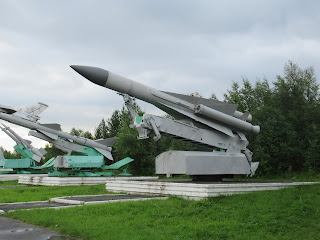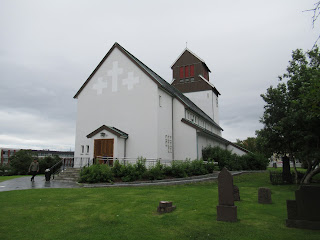I missed a few monuments yesterday such as this one to the codfish so before my trip to Kirkenes in Norway, I had a quick look. You will know that cod is very important to the local economy if you read yesterday's post.
Then I was picked up by my driver whose name I have already forgotten, my guide Mila and my interpreter for English, Russian and Norwegian, Vadim whose brother I had arranged the trip with Yaroslavl. This was to be a day trip 186kms from Murmansk to the border to cross it and visit Kirkenes. There was another stop at a monument to the armed forces and a monument to the anti aircraft batteries that surrounded the city and operated by women. A SAM missile...
...the same type of jet that bought down Gary Powers...
...a Yak fighter but any aircraft spotter will note that the wings and the fuselage are from different types of aircraft.
A depiction of where the batteries where placed around Murmansk.
The memorial to the fallen battery soldiers.
A monument to the women battery operators and a detail of the central plaque.
A nearby bomb shelter.
Then it was back on the road to cross the taiga...
...past lakes...
...and tundra...
To another monument which is erected on the furthest point of the German advance with the Soviet positions in the distance and the German positions behind me.
A memorial to the fallen and all of the names of the dead, soldiers, sailors, marines and merchant marine plus several civilian caught up in the fighting.
The obligatory tank.
More od =f the same memorial site.
Then we moved on to Titovka where we mad a break for a coffee and yet another memorial...you are encouraged to ring the bell to remember the fallen.
This is a war time mobile communications centre which is now home to a number of artefacts...more of a collection than a museum.
Inside the van.
We passed an army training ground and a base called Sputnik as Yuri Gagarin was stationed here very early in his career.= and the nearby base simply called 19kms. There is also a large town built solely to house the workers for the Norilsk nickel mine and processing plant.
Then we crossed the border an inte Norway.
Kirkenes is a lot smaller than I had thought. It was totally destroyed in the war. It has less than 3,000 people in the town and about the same number in the surrounding area. There is little of historic value to see . The church was only built in 1959 and inside is very plain after being the very ornate Russian Orthodox churches.
The cemetery is empty except for a few headstones and some that survived the war but few of great funeral architectural merit.
The houses are the usual bright colours that I associate with small Norwegian communities.

One of the things that I specifically wanted to see was the underground shelter able to hold 600 people...but it only opens at 12.30 on certain days or by appointment for groups of more than ten.
The entrance to the shelter.
The finger post outside the shelter showing distances to various cities.
The Monument to the Soviet Soldiers, a side on view,
And a full frontal but it was an overcast day and it isn't a good shot but it gives you an idea.
I went to the local museum which is interesting but it is only small but fills in an hour of local customs and life in the town during the war.
The port was a major transhipment point for the Germans during the war but it is very quiet now with just a few local fishing boats, a small repair yard and the occasional cruise liner such as the Albatross, a German cruise liner. There is also an ore transhipment berth to ship out locally mined ores.
A local fishing boat.The bunkering depot.
One of many reindeer in the area.
A waterfall seen fro the main road on our return journey.







































No comments:
Post a Comment